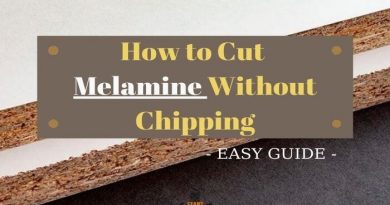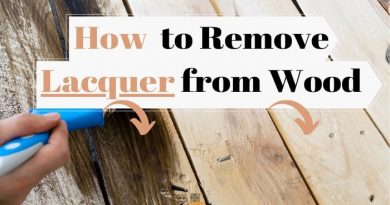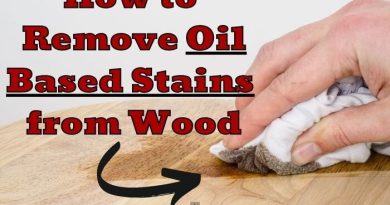Quickly Remove Expanding Foam from Wood! 6 Proven Methods!
| Wood Surface Type | Expanding Foam Removal Method | Safety for Wood |
|---|---|---|
| Wood Floors | Razor Blade & Sandpaper | Safe for bare wood; test on finished areas. |
| Wood Furniture | Vegetable Oil & Plastic Scraper | Safe for most finishes; oil may darken some woods. |
| Wood Doors & Windows | Acetone & Putty Knife | Risky for finished or painted surfaces; use with caution. |
| Painted Wood Surfaces | Murphy’s Oil Soap & Cloth | Generally safe; may affect some paints or finishes. |
Remove Fresh Expanding Foam from Wood Surfaces
It is best to wait until the expanding foam is dry to remove it. Its sticky surface will become inactive as it dries and you will have an easier time peeling it off.
Method #1. Using a Cloth and Vegetable Oil
What You Need:
- Cloth
- Vegetable oil
- Gloves
- Mild detergent
- Water
- Act Quickly: The key to removing fresh expanding foam is to act while it’s still wet. Fresh foam is much easier to remove before it cures. So, as soon as you notice the spill, grab a cloth and vegetable oil.
- Protect Your Hands: Before you start, make sure to wear gloves. Fresh expanding foam is sticky and can be a hassle to remove from your skin.
- Apply Vegetable Oil: Pour a generous amount of vegetable oil onto a clean cloth. Any common kitchen oil, like canola or olive oil, will work. The oil acts as a solvent to break down the foam, making it less adhesive and easier to wipe off.
- Gently Blot the Foam: Press the oil-soaked cloth against the foam. Blot gently rather than rub to avoid pushing the foam deeper into the wood grain. The oil will start to break down the foam’s structure, loosening its bond with the wood surface.
- Wipe Off the Foam: Once the foam starts to dissolve, use the cloth to slowly wipe it away from the wood. You may need to reapply oil to the cloth several times to keep it effective. The goal is to lift the foam off the wood without spreading it around.
- Clean the Wood Surface: After you’ve removed the bulk of the foam, there may be an oily residue left on the wood. Use a fresh cloth and a mild detergent with water to clean the area thoroughly. Wipe with the grain of the wood to avoid any additional damage.
- Dry the Wood: Once the foam and oil are removed, and the surface is clean, dry the wood completely with another clean cloth. It’s important to remove all moisture to prevent any warping or damage to the wood.
- Inspect and Touch Up: Finally, inspect the wood for any damage or discoloration. If the finish has been affected, you may need to touch up the area with wood stain or sealant to restore its appearance.
Method #2. Using Nail Polish Remover
What You Need:
- Nail polish remover (acetone)
- Gloves
- Clean, soft cloth
- Water
- Mild detergent
- Prepare the Area: First, I make sure the work area is well-ventilated because nail polish remover fumes can be strong and potentially harmful. I also wear gloves to protect my hands from both the foam and the acetone.
- Test the Remover: Before I begin, I quickly apply a small amount of nail polish remover to an inconspicuous part of the wood to test for any adverse reaction. This ensures that the solvent won’t damage the finish or color of the wood.
- Apply the Remover: Once I’ve confirmed it’s safe to use, I pour some nail polish remover onto a clean, soft cloth. I choose a cloth that won’t fall apart or leave lint behind, as this could stick to the foam and make the situation worse.
- Blot the Foam: I gently dab the foam with the cloth soaked in nail polish remover. Blotting is crucial because rubbing might push the foam deeper into the wood grain. The acetone in the nail polish remover starts to break down the foam’s structure on contact, making it easier to remove.
- Wipe Away the Foam: As the foam begins to dissolve, I use the cloth to carefully wipe the foam off the wood surface. I continue to apply nail polish remover as needed, turning the cloth to a clean area frequently to avoid re-depositing the foam.
- Clean the Wood: After removing the foam, there might be a residue from the nail polish remover. To clean this off, I use a new cloth dampened with water and a mild detergent, wiping in the direction of the wood grain to maintain the integrity of the wood.
- Dry and Inspect the Surface: I dry the wood thoroughly with another clean cloth. Once the wood is dry, I inspect the area to ensure all foam residue is gone and the wood’s finish is intact. If the finish has been compromised, I may need to sand the area lightly and reapply a matching wood finish to restore its appearance.
Method #3. Using WD-40
What You Need:
- Ventilation
- Gloves
- WD-40
- Clean, soft cloth
- Water
- Ventilate and Protect: I always start by ensuring the area is well-ventilated because WD-40 has a strong odor and contains chemicals that shouldn’t be inhaled in concentrated amounts. I also don gloves to protect my skin from both the foam and the WD-40.
- Apply WD-40: I spray a liberal amount of WD-40 directly onto the foam. The lubricating properties of WD-40 help to loosen the foam’s grip on the wood surface. I give it a moment to penetrate the foam, but not too long since the foam is still wet and more manageable.
- Wipe the Foam: Using a clean rag or cloth, I begin to wipe away the foam. The WD-40 should have made the foam less sticky, allowing it to come off the wood more easily. I use a gentle touch to avoid damaging the wood’s finish, and I frequently switch to clean areas of the cloth to avoid smearing the foam.
- Clean the Residue: Once the foam is removed, there will likely be a residue from the WD-40. I use a fresh cloth with mild soapy water to clean off any remaining WD-40 and foam residue, making sure to move in the direction of the wood grain to prevent scratching.
- Dry the Surface: After the wood is clean, I thoroughly dry it with another clean, dry cloth. It’s important to remove all moisture to prevent any water damage or warping to the wood.
- Inspect and Repair: Finally, I inspect the wood for any damage to the finish. If necessary, I lightly sand the affected area and reapply a matching finish to restore the wood’s natural beauty.
Remove Dried Expanding Foam from Wood Surfaces
Method #1. Using a Putty Knife and Acetone
What You Need:
- Well-ventilated area
- Protective gloves and eyewear
- Sharp putty knife
- Clean rag
- Mild detergent
- Clean, dry cloth
- Safety First: Before starting, I ensure that I’m in a well-ventilated area since acetone fumes are potent and can be harmful. I also don protective gloves and eyewear to safeguard against splashes.
- Initial Scraping: With a sharp putty knife, I carefully begin to scrape away the dried foam. I hold the knife at a low angle relative to the wood to reduce the risk of gouging the surface. I use gentle, consistent pressure to remove as much of the foam as possible.
- Apply Acetone: After scraping off the bulk of the foam, I dampen a clean rag with acetone. I then gently dab the remaining foam with the acetone-soaked rag. Acetone is a powerful solvent that breaks down the adhesive properties of the foam, making it easier to remove.
- Final Scraping: Once the acetone has softened the foam, I take the putty knife again and carefully scrape away the residue. The foam should now be much softer and easier to remove without damaging the wood.
- Clean the Surface: After all the foam is removed, I clean the wood surface with a fresh cloth and mild detergent to remove any remaining acetone, as it can dry out and damage the wood if left on.
- Dry and Assess: I then dry the wood thoroughly with a clean, dry cloth. Finally, I assess the area to ensure all foam and acetone residues are gone and check the wood’s finish for any damage. If the finish has been affected, I lightly sand the area and reapply a matching wood finish to restore the wood’s natural beauty.
It’s crucial to work carefully and patiently, especially when using a putty knife and acetone, to avoid damaging the wood surface. Always test the acetone on a hidden area first to ensure it won’t harm the finish.
Method #2. Using a Serrated Bread Knife and Murphy’s oil
What You Need:
- Serrated bread knife
- Murphy’s Oil Soap
- Plastic scraper or credit card
- Mild detergent
- Clean, dry cloth
- Acetone
- Careful Slicing: I start by gently sawing at the dried foam with the serrated bread knife. The key here is to use the knife’s serrated edge to grip and cut through the foam without applying too much pressure, which could damage the wood underneath. I aim to slice off the bulk of the foam, leaving only a thin layer adhered to the wood to minimize the risk of scratching the finish.
- Apply Murphy’s Oil: Once the majority of the foam is removed, I apply Murphy’s Oil Soap directly to the remaining foam residue. This oil soap is designed to clean wood surfaces without harsh chemicals, making it safe for most finishes. I let it sit for a minute to penetrate and soften the foam.
- Gentle Scrubbing: After the Murphy’s Oil has had a chance to work, I use a plastic scraper or the edge of a discarded credit card to gently scrub away the softened foam. These tools are less likely to scratch the wood than a metal knife.
- Wipe and Rinse: With a damp cloth, I wipe away any loosened foam particles and remaining Murphy’s Oil. I might need to rinse the cloth a few times to ensure all the residue is gone.
- Buff the Wood: To finish, I dry the area with a clean towel and then buff it with a soft, dry cloth to restore the wood’s natural luster. If the wood’s finish appears dull or damaged from the foam, I might need to touch it up with a matching wood finish.
Method #3. Using a Razor Blade and Sandpaper
What You Need:
- Razor blade
- Sandpaper
- Plastic scraper or credit card (optional)
- Mild detergent
- Clean, dry cloth
- Careful Scraping: I start by using a razor blade, holding it at a flat angle to the wood surface to avoid digging into the wood grain. I use the blade to carefully scrape off the bulk of the dried foam. The goal here is to remove as much foam as possible without damaging the wood, so I proceed with a steady, controlled motion.
- Sanding the Residue: Once I’ve removed the majority of the foam, I switch to sandpaper. I typically use a fine-grit sandpaper, such as 120-grit, to gently sand away any remaining foam residue. Sanding in the direction of the wood grain prevents scratches and ensures a smooth finish.
- Final Touches: After the residue is sanded off, I might need to go over the area with a finer grit sandpaper, like 220-grit, to smooth out any roughness and to blend the sanded area with the surrounding wood surface.
- Clean Up: I finish by wiping the area with a tack cloth to remove all the sanding dust. It’s important to have a clean surface before applying any finish or paint.
- Restore Finish: If the wood’s finish has been compromised, I’ll match the existing finish and reapply it to the sanded area, ensuring a seamless repair.
Common Mistakes to Avoid
As a professional woodworker with expertise in removing expanding foam from wood, I can share some common mistakes people often make during the removal process and provide guidance on how to avoid them:
- Scraping Too Aggressively: One of the most common mistakes is using too much force when scraping off the foam, which can gouge or scratch the wood surface. To avoid this, use a plastic scraper or putty knife and gently work at the edges of the foam to lift it away without damaging the wood.
- Not Protecting the Surrounding Area: Failing to mask off areas around the foam can result in damage to adjacent surfaces or spread the mess. Always use painter’s tape and drop cloths to protect surrounding areas before starting the removal process.
- Using the Wrong Solvent: People often reach for harsh chemicals that can damage the wood’s finish. Always test any solvent in an inconspicuous area first, and opt for solvents like acetone or rubbing alcohol that are less likely to harm the wood.
- Not Wearing Protective Gear: Skipping safety equipment like gloves and eyewear can lead to skin irritation or eye damage, especially when using chemical solvents. Always wear the appropriate protective gear to safeguard against these risks.
- Ignoring the Foam’s Cure Time: Attempting to remove foam after it has fully cured makes the job much harder. If possible, address the spill as soon as it happens, when the foam is still wet and easier to wipe away with a cloth soaked in solvent.
- Over-sanding the Area: In an attempt to remove residue, some may sand the area too much, leading to uneven surfaces or removal of too much wood. Sand lightly and evenly, just enough to remove the residue without altering the shape or surface of the wood.
- Not Cleaning the Area Afterward: After removal, some people forget to clean the wood surface, leaving behind solvent residue or foam particles. Clean the area with a damp cloth and mild detergent, then dry it thoroughly to prevent any further damage.
- Applying Too Much Heat: Using a heat gun to soften the foam can be effective, but applying too much heat can scorch or burn the wood. Use the lowest heat setting and keep the heat gun moving to avoid overheating any spot.
- Lack of Patience: Rushing the process can result in more damage. Take your time to gently remove the foam, especially when it’s partially cured and more difficult to remove. Patience is key to preserving the integrity of the wood surface.
Prevention Tips to Help Avoid Accidental Foam Spills on Wood Surfaces
- Use Masking Tape: Before applying expanding foam, use high-quality painter’s tape to mask off the wood surfaces adjacent to the area where you’ll be working. This will create a barrier that catches any accidental overspray or drips.
- Apply Drop Cloths or Plastic Sheeting: Cover large areas or furniture with drop cloths or plastic sheeting to protect them from stray foam. Secure the edges with tape to prevent it from moving during your work.
- Work Slowly and Carefully: Rushing the application process can lead to mistakes. Take your time to apply the foam slowly, which allows for better control and precision.
- Use Foam with Precision Nozzles: Some expanding foam products come with precision nozzles or tubes that allow for more controlled application. Using these can help direct the foam exactly where it’s needed and reduce the risk of spills.
- Practice First: If you’re new to using expanding foam, practice applying it on scrap materials first. This will help you get a feel for the flow rate and expansion rate of the foam.
- Fill in Stages: If you’re filling a large gap or hole, do it in stages rather than trying to fill it all at once. This reduces the chance of overflow and allows you to manage the application more effectively.
- Keep Cleaning Supplies Handy: Have acetone or another appropriate solvent ready along with clean rags in case of spills. If foam does get onto a wood surface, you can act quickly to remove it before it cures.
- Check the Wood Surface: Ensure that the wood surface is clean and dry before application, as dirt and moisture can cause the foam to adhere less predictably, increasing the chance of spills.
- Use Protective Barriers: For larger projects, consider using physical barriers such as plywood or cardboard to shield wood surfaces from accidental foam exposure.
- Wear Proper Gloves: Use gloves that allow for dexterity and a good grip on the foam canister to prevent slips and accidental discharge.
- Read Instructions Thoroughly: Each foam product may have specific instructions for use. Familiarize yourself with these to ensure you’re using the product correctly and safely.




